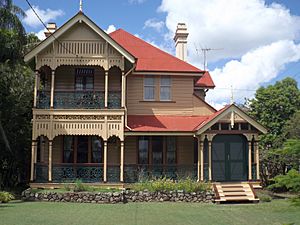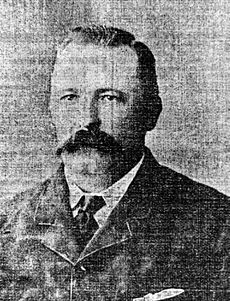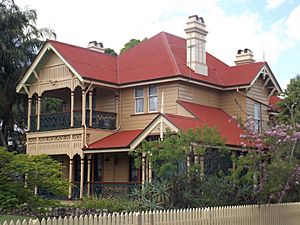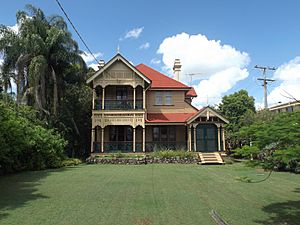Nassagaweya, West End facts for kids
Quick facts for kids Nassagaweya |
|
|---|---|

Residence in 2015
|
|
| Location | 37 Gray Road, West End, Queensland, Australia |
| Design period | 1870s - 1890s (late 19th century) |
| Built | c. 1885 |
| Architect | Arthur Morry |
| Official name: Nassagaweya | |
| Type | state heritage (built) |
| Designated | 21 October 1992 |
| Reference no. | 600227 |
| Significant period | 1880s (fabric) 1880s-1890s ( historical) |
| Significant components | service wing, residential accommodation - main house |
| Lua error in Module:Location_map at line 420: attempt to index field 'wikibase' (a nil value). | |
Nassagaweya is a special old house in West End, Queensland, Australia. It's listed as a heritage site, which means it's an important part of history. The house was designed by an architect named Arthur Morry and built around 1885. It was officially added to the Queensland Heritage Register on October 21, 1992, to protect its historical value.
The Story of Nassagaweya
Nassagaweya was built around 1885 by its designer, Arthur Morry. He was an architect, which is someone who designs buildings. This house was actually his own home! Arthur Morry later became a very important person in the community. He was the mayor of the City of South Brisbane, which means he was the leader of the local government. He also became a Member of the Queensland Legislative Assembly, acting like a politician for the South Brisbane area.
Arthur Morry moved out of the house in 1895. For a while, it was probably rented out to different people. Then, in 1915, a man from Scotland and Canada named John Gillies bought it. He decided to name the house Nassagaweya. This name came from his hometown, Nassagaweya Township in Ontario, Canada. It's a word from the Delaware Indian language that means "home by the maple forests."
John Gillies lived in the house until he passed away in 1946. The house is still owned by his family today. If you visit, you'll notice that the streets around the house are named Gray and Morry. These names honor two of the house's past owners: Gray and Arthur Morry himself.
What Nassagaweya Looks Like
Nassagaweya is a two-story house made of timber, which is wood. It was built around 1885. The roof is shaped like a pyramid and is covered with corrugated iron, though it used to be made of slate. The house sits on a corner block of land. The main part of the house is square-shaped, with several parts that stick out, especially towards the streets. These parts have pointed roofs, called gables.
The front of the house has a large, two-story porch area on the left side. This porch has pretty metal railings and decorations, and a fancy wooden trim. On the right side, there's a smaller covered entrance called a portico. This leads to a small porch that is closed off with wooden slats, like blinds.
The side of the house has a mix of different porch areas. Some porches are built into the house, and there's also the slatted porch and a kitchen entrance that sticks out. Inside, the rooms and the wooden details are very unique and show how creative the design was. The house hasn't changed much over the years, except for one room that was added at the back. Overall, the house has a very unusual and charming look.
Sadly, other buildings that used to be on the property, like stables, burned down a while ago.
Why Nassagaweya is Important
Nassagaweya was added to the Queensland Heritage Register on October 21, 1992, because it meets several important rules.
It shows how Queensland's history has changed. This house is one of several large wooden homes built in the Hill End area during the 1880s. This was a time when the area was growing fast.
It shows what old houses were like. Nassagaweya is important because it's a unique and well-preserved house from the 1880s. It helps us understand how homes were designed and built back then.
It is connected to an important person in Queensland's history. Nassagaweya is special because it was the home of architect and politician Arthur Morry. His connection to the house makes it even more historically significant.




